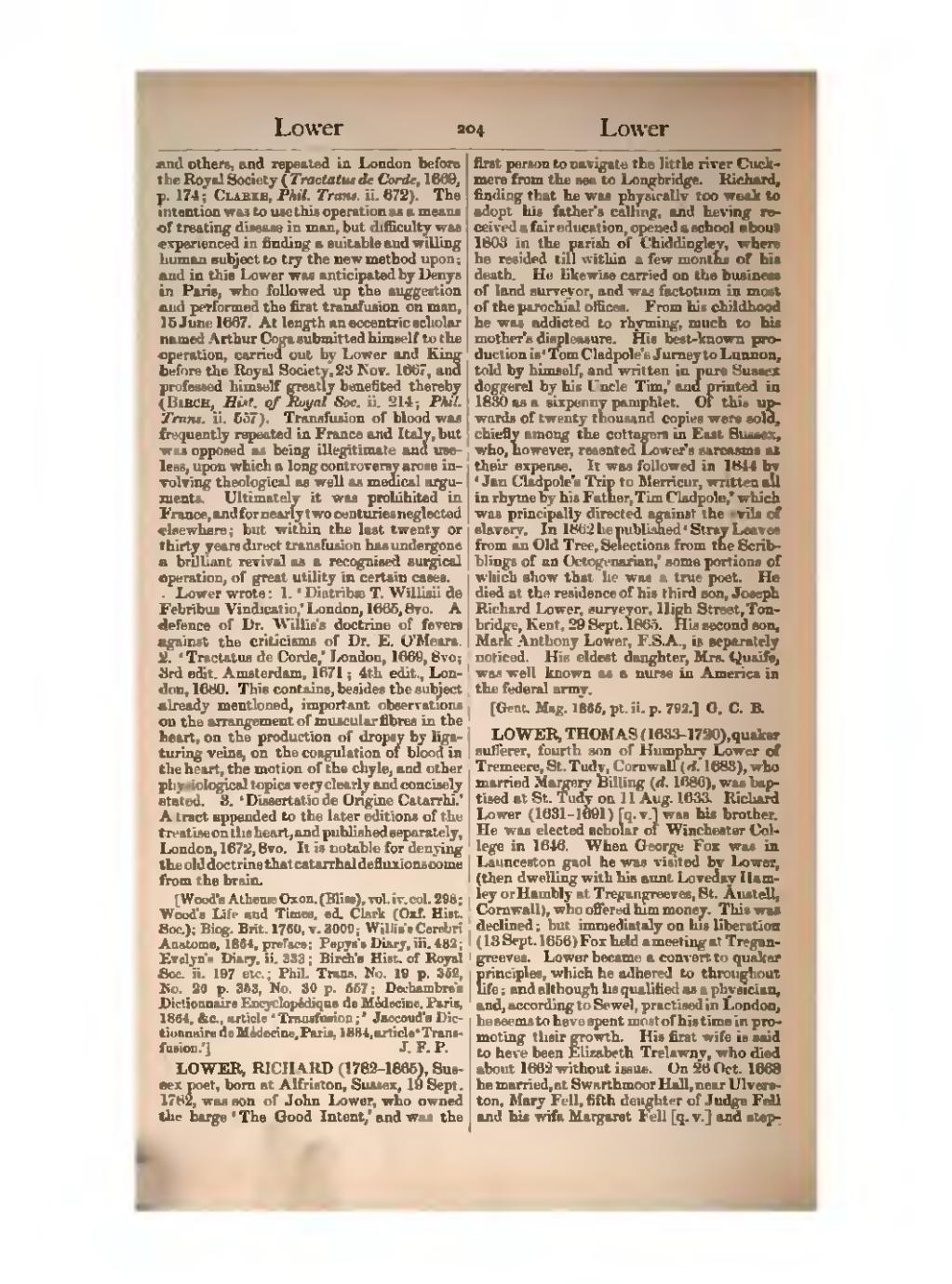and others, and repeated in London before the Royal Society (Tractatus de Corde, 1669, p. 174; Clarke, Phil. Trans. ii. 672). The intention was to use this operation as a means of treating disease in man, but difficulty was experienced in finding a suitable and willing human subject to try the new method upon; and in this Lower was anticipated by Denys in Paris, who followed up the suggestion and performed the first transfusion on man, 15 June 1667. At length an eccentric scholar named Arthur Coga submitted himself to the operation, carried out by Lower and King before the Royal Society, 23 Nov. 1667, and professed himself greatly benefited thereby (Birch, Hist. of Royal Soc. ii. 214; Phil. Trans. ii. 557). Transfusion of blood was frequently repeated in France and Italy, but was opposed as being illegitimate and useless, upon which a long controversy arose involving theological as well as medical arguments. Ultimately it was prohibited in France, and for nearly two centuries neglected elsewhere; but within the last twenty or thirty years direct transfusion has undergone a brilliant revival as a recognised surgical operation, of great utility in certain cases.
Lower wrote: 1. ‘Diatribæ T. Willisii de Febribus Vindicatio,’ Lond., 1665, 8vo. A defence of Dr. Willis's doctrine of fevers against the criticisms of Dr. E. O'Meara [q. v.] 2. ‘Tractatus de Corde,’ Lond., 1669, 8vo; 3rd ed. Amsterdam, 1671; 4th ed. Lond., 1680. This contains, besides the subject already mentioned, important observations on the arrangement of muscular fibres in the heart, on the production of dropsy by ligaturing veins, on the coagulation of blood in the heart, the motion of the chyle, and other physiological topics very clearly and concisely stated. 3. ‘Dissertatio de Origine Catarrhi.’ A tract appended to the later editions of the treatise on the heart, and published separately, Lond. 1672, 8vo. It is notable for denying the old doctrine that catarrhal defluxions come from the brain.
[Wood's Athenæ Oxon. (Bliss), vol. iv. col. 298; Wood's Life and Times, ed. Clark (Oxf. Hist. Soc.); Biog. Brit. 1760, v. 3009; Willis's Cerebri Anatome, 1664, pref.; Oldham's Poems, ed. Bell, 9, 10, 180; Pepys's Diary, iii. 482; Evelyn's Diary, ii. 333; Birch's Hist. Roy. Soc. ii. 197 etc.; Phil. Trans. No. 19 p. 352, No. 20 p. 353, No. 30 p. 557; Prof. Gotch's Two Oxford Physiologists—Lower and Mayow, 1907; Dechambre's Dictionnaire Encyc. de Médecine, Paris, 1864, &c., art. ‘Transfusion;’ Jaccoud's Dictionnaire de Médecine, Paris, 1884, art. ‘Transfusion.’]
LOWER, RICHARD (1782–1865), Sussex poet, born at Alfriston, Sussex, 19 Sept. 1782, was son of John Lower, who owned the barge ‘The Good Intent,’ and was the first person to navigate the little river Cuckmere from the sea to Longbridge. Richard, finding that he was physically too weak to adopt his father's calling, and having received a fair education, opened a school about 1803 in the parish of Chiddingley, where he resided till within a few months of his death. He likewise carried on the business of land surveyor, and was factotum in most of the parochial offices. From his childhood he was addicted to rhyming, much to his mother's displeasure. His best-known production is ‘Tom Cladpole's Jurney to Lunnon, told by himself, and written in pure Sussex doggerel by his Uncle Tim,’ and printed in 1830 as a sixpenny pamphlet. Of this upwards of twenty thousand copies were sold, chiefly among the cottagers in East Sussex, who, however, resented Lower's sarcasms at their expense. It was followed in 1844 by ‘Jan Cladpole's Trip to Merricur, written all in rhyme by his Father, Tim Cladpole,’ which was principally directed against the evils of slavery. In 1862 he published ‘Stray Leaves from an Old Tree, Selections from the Scribblings of an Octogenarian,’ some portions of which show that he was a true poet. He died at the residence of his third son, Joseph Richard Lower, surveyor, High Street, Tonbridge, Kent, 29 Sept. 1865. His second son, Mark Anthony Lower, F.S.A. [q. v.], is separately noticed. His eldest daughter, Mrs. Quaife, was well known as a nurse in America in the federal army.
[Gent. Mag. 1865, pt. ii. p. 792.]
LOWER, THOMAS (1633–1720), quaker sufferer, fourth son of Humphry Lower of Tremeere, St. Tudy, Cornwall (d. 1683), who married Margery Billing (d. 1686), was baptised at St. Tudy on 11 Aug. 1633. Richard Lower (1631–1691) [q. v.] was his brother. He was elected scholar of Winchester College in 1646. When George Fox was in Launceston gaol he was visited by Lower, (then dwelling with his aunt Loveday Hamley or Hambly at Tregangreeves, St. Austell, Cornwall), who offered him money. This was declined; but immediately on his liberation (13 Sept. 1656) Fox held a meeting at Tregangreeves. Lower became a convert to quaker principles, which he adhered to throughout life; and although he qualified as a physician, and, according to Sewel, practised in London, he seems to have spent most of his time in promoting their growth. His first wife is said to have been Elizabeth Trelawny, who died about 1662 without issue. On 26 Oct. 1668 he married, at Swarthmoor Hall, near Ulverston, Mary Fell, fifth daughter of Judge Fell and his wife Margaret Fell [q. v.] and step-
